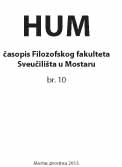DEMOGRAFSKE ZNAČAJKE ŽUPE BAĆINA OD 1870. DO 1880. GODINE
DEMOGRAPHIC CHARACTERISTICS OF THE BAĆINA PARISH (1870. – 1880.)
Author(s): Žarko DugandžićSubject(s): History
Published by: Filozofski fakultet Sveučilišta u Mostaru
Keywords: Parish Baćina; Neretva Valley; birth rate; mortality; nuptiality; natural increase
Summary/Abstract: Both components of the natural movement of the population are on the transition from high to low. The average annual birth rate ranges at the level of 29.60 ‰ and thus found itself at the beginning of the demographic transition, fertility, and the average mortality rate captures the mean mortality and is about 17.70 ‰, and all this suggests that the parish Baćina already found itself early in the process of demographic transition. In this development process, in which both components of the natural movement have dropped, the resultant provides a moderate rate of natural increase, which amounts to 9.17 ‰. Rhythm is the conception pronounced during the spring, while in autumn the least, probably because they are busy autumn population works in the field. In the total number of births in the parish there were no reports of illegitimate child birth, which shows the non-patriarchal tradition population. The parish is Baćina during Herzegovina uprising was significantly less burdened by refugees from BiH in relation to other Neretva parishes, so this is one of the reasons for these demographic trends. The parish still recorded high mortality in childhood (0-14), but in fertile age, as a result of poor living conditions and various diseases. During this survey there were recorded more marriages in consanguinity, which speaks of a kind of isolationism directionality to their own population and low level of space mobility of population.
Journal: Hum
- Issue Year: 2013
- Issue No: 10
- Page Range: 420-451
- Page Count: 32
- Language: Croatian

